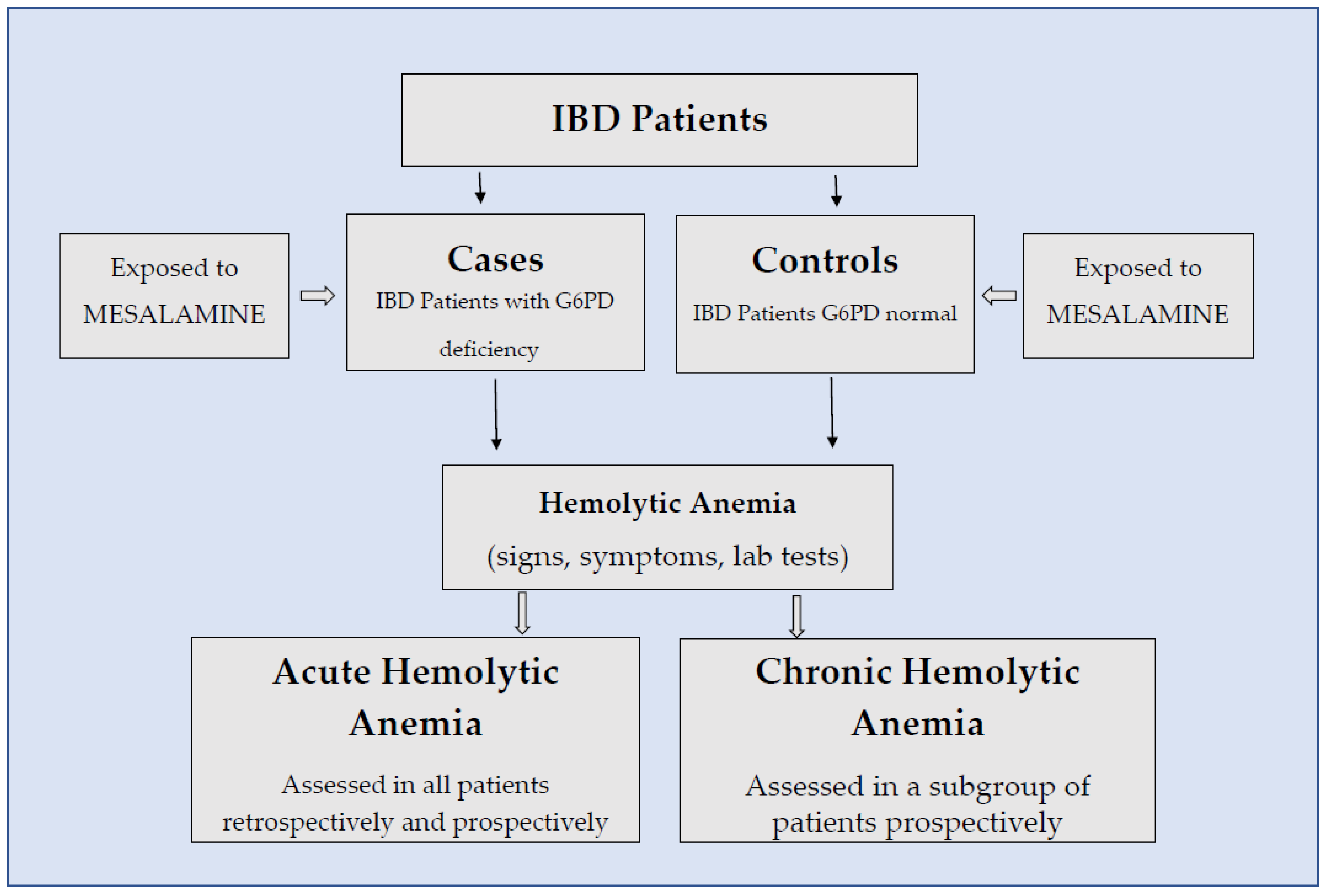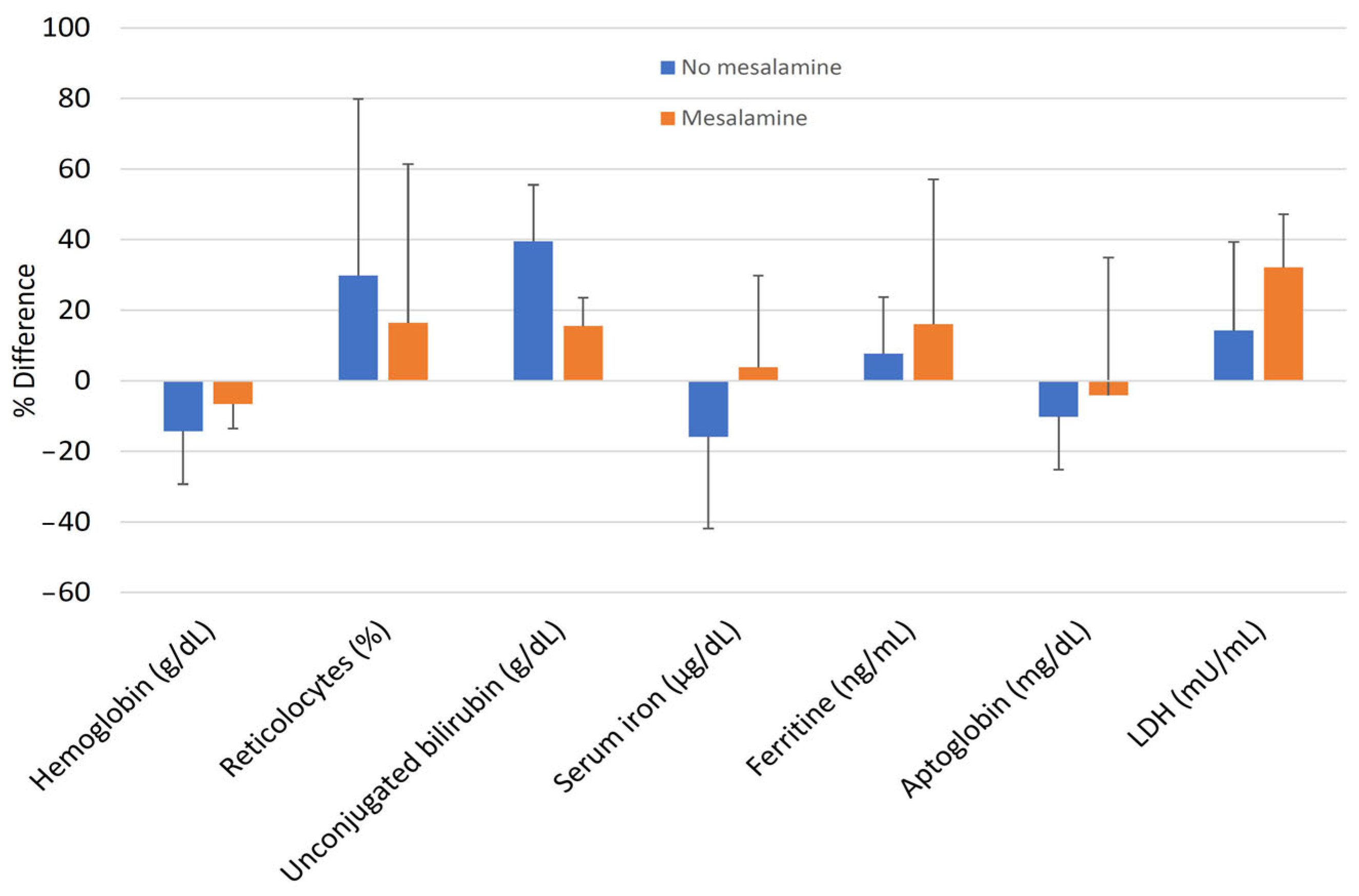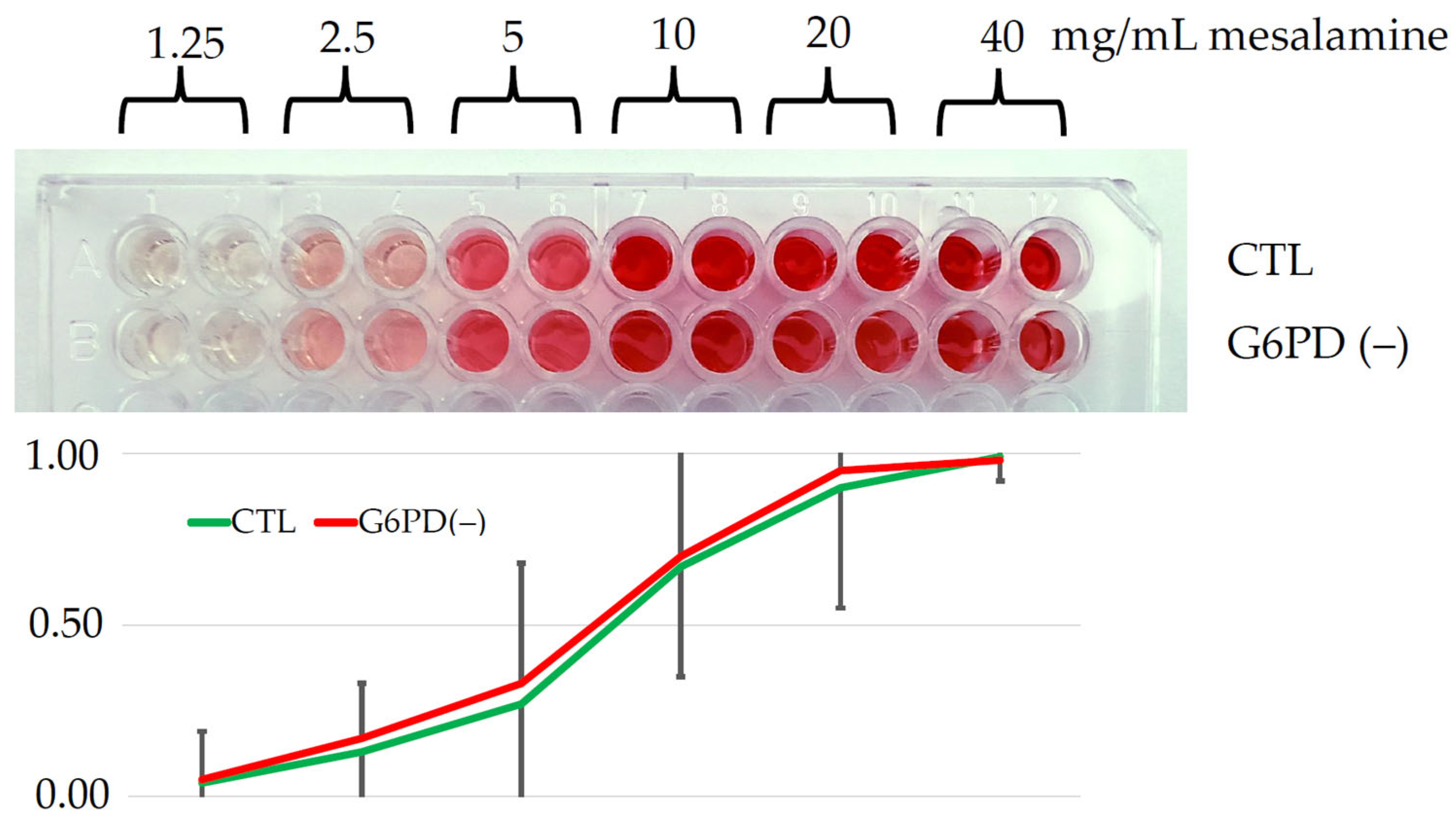Risk of Hemolytic Anemia in IBD Patients with Glucose-6-Phosphate Dehydrogenase Deficiency Treated with Mesalamine: Results of a Retrospective-Prospective and Ex Vivo Study
Abstract
1. Introduction
2. Materials and Methods
2.1. Study Design
2.2. Setting
2.3. Eligibility
2.4. Data Collection
2.5. Hemolytic Anemia
2.6. Determination of G6PD Activity
2.7. Ex Vivo Chemotoxicity of Mesalamine
2.8. Statistical Analysis
3. Results
Ex Vivo Chemotoxicity of Mesalamine
4. Discussion
5. Conclusions
Supplementary Materials
Author Contributions
Funding
Institutional Review Board Statement
Informed Consent Statement
Data Availability Statement
Conflicts of Interest
References
- Abraham, C.; Cho, J.H. Inflammatory bowel disease. N. Engl. J. Med. 2009, 361, 2066–2078. [Google Scholar] [CrossRef] [PubMed]
- Iacucci, M.; de Silva, S.; Ghosh, S. Mesalazine in inflammatory bowel disease: A trendy topic once again? Can. J. Gastroenterol. 2010, 24, 127–133. [Google Scholar] [CrossRef]
- Stenson, W.F.; Lobos, E. Sulfasalazine inhibits the synthesis of chemotactic lipids by neutrophils. J. Clin. Invest. 1982, 69, 494–497. [Google Scholar] [CrossRef] [PubMed]
- Gadangi, P.; Longaker, M.; Naime, D.; Levin, R.I.; Recht, P.A.; Montesinos, M.C.; Buckley, M.T.; Carlin, G.; Cronstein, B.N. The anti-inflammatory mechanism of sulfasalazine is related to adenosine release at inflamed sites. J. Immunol. 1996, 156, 1937–1941. [Google Scholar] [CrossRef]
- Stevens, C.; Lipman, M.; Fabry, S.; Moscovitch-Lopatin, M.; Almawi, W.; Keresztes, S.; Peppercorn, M.A.; Strom, T.B. 5-Aminosalicylic acid abrogates T-cell proliferation by blocking interleukin-2 production in peripheral blood mononuclear cells. J. Pharmacol. Exp. Ther. 1995, 272, 399–406. [Google Scholar]
- Ordas, I.; Eckmann, L.; Talamini, M.; Baumgart, D.C.; Sandborn, W.J. Ulcerative colitis. Lancet 2012, 380, 1606–1619. [Google Scholar] [CrossRef] [PubMed]
- Feagan, B.G.; Macdonald, J.K. Oral 5-aminosalicylic acid for maintenance of remission in ulcerative colitis. Cochrane Database Syst. Rev. 2012, 10, CD000544. [Google Scholar] [CrossRef] [PubMed]
- Available online: https://www.g6pd.org/en/G6PDDeficiency/SafeUnsafe/DaEvitare_ISS-it (accessed on 14 April 2023).
- Available online: https://www.aifa.gov.it/documents/20142/241044/elenco_dei_farmaci_G6PD.pdf (accessed on 14 March 2023).
- American Autoimmune Related Diseases Association. Available online: http://www.aarda.org (accessed on 14 March 2023).
- Available online: https://ansm.sante.fr/actualites/medicament-et-deficit-en-g6pd-lansm-actualise-le-referentiel (accessed on 14 March 2023).
- Maffi, D.; Caforio, M.; Pasquino, M.; Caprari, P. Deficit di Glucosio Fosfato Deidrogenasi e Farmaci; Istituto Superiore di Sanità: Rome, Italy, 2009. [Google Scholar]
- Howes, R.E.; Piel, F.B.; Patil, A.P.; Nyangiri, O.A.; Gething, P.W.; Dewi, M.; Hogg, M.M.; Battle, K.E.; Padilla, C.D.; Baird, J.K.; et al. G6PD deficiency prevalence and estimates of affected populations in malaria endemic countries: A geostatistical model-based map. PLoS Med. 2012, 9, e1001339. [Google Scholar] [CrossRef]
- Siniscalco, M.; Bernini, L.; Latte, B.; Motulsky, A.G. Favism and Thalassæmia in Sardinia and their Relationship to Malaria. Nature 1961, 190, 1179–1180. [Google Scholar] [CrossRef]
- Oppenheim, A.; Jury, C.L.; Rund, D.; Vulliamy, T.J.; Luzzatto, L. G6PD Mediterranean accounts for the high prevalence of G6PD deficiency in Kurdish Jews. Hum. Genet. 1993, 91, 293–294. [Google Scholar] [CrossRef]
- Luzzatto, L.; Ally, M.; Notaro, R. Glucose-6-phosphate dehydrogenase deficiency. Blood 2020, 136, 1225–1240. [Google Scholar] [CrossRef] [PubMed]
- Errigo, A.; Bitti, A.; Galistu, F.; Salis, R.; Pes, G.M.; Dore, M.P. Relationship between Glucose-6-Phosphate Dehydrogenase Deficiency, X-Chromosome Inactivation and Inflammatory Markers. Antioxidants 2023, 12, 334. [Google Scholar] [CrossRef]
- Fiorelli, G.; Meloni, T.; Palomba, V.; Manoussakis, C.; Villa, S.; Cappellini, M.D. Gene frequency of glucose-6-phosphate dehydrogenase (G6PD) polymorphic variants in Sardinia. Gene Geogr. 1990, 4, 139–142. [Google Scholar] [PubMed]
- WHO Working Group. Glucose-6-phosphate dehydrogenase deficiency. Bull. World Health Organ. 1989, 67, 601–611. [Google Scholar]
- Pamba, A.; Richardson, N.D.; Carter, N.; Duparc, S.; Premji, Z.; Tiono, A.B.; Luzzatto, L. Clinical spectrum and severity of hemolytic anemia in glucose 6-phosphate dehydrogenase-deficient children receiving dapsone. Blood 2012, 120, 4123–4133. [Google Scholar] [CrossRef]
- Cavalli-Sforza, L.L. Genes, Peoples and Languages; University of California Press: Los Angeles, CA, USA, 2001. [Google Scholar]
- Mosca, A.; Paleari, R.; Rosti, E.; Luzzana, M.; Barella, S.; Sollaino, C.; Galanello, R. Simultaneous automated determination of glucose 6-phosphate dehydrogenase and 6-phosphogluconate dehydrogenase activities in whole blood. Eur. J. Clin. Chem. Clin. Biochem. 1996, 34, 431–438. [Google Scholar] [CrossRef]
- Roper, D.; Layton, M.; Rees, D.; Lambert, C.; Vulliamy, T.; De la Salle, B.; D’Souza, C.; British Society for Haematology. Laboratory diagnosis of G6PD deficiency. A British Society for Haematology Guideline. Br. J. Haematol. 2020, 189, 24–38. [Google Scholar] [CrossRef]
- Dacie, J.V.; Lewis, S.M. Practical Haematology, 7th ed.; Churchil Livingstone: Edinburgh, UK, 1991. [Google Scholar]
- Vande Casteele, N.; Jakate, A.; McNamee, B.; Sandborn, W.J. Similar pharmacokinetics of three dosing regimens comprising two oral delayed-release mesalamine formulations in healthy adult volunteers: Randomised, open-label, parallel-group study. Br. J. Clin. Pharmacol. 2021, 87, 1141–1149. [Google Scholar] [CrossRef]
- Lichtenstein, G.R.; Loftus, E.V.; Isaacs, K.L.; Regueiro, M.D.; Gerson, L.B.; Sands, B.E. ACG Clinical Guideline: Management of Crohn’s Disease in Adults. Am. J. Gastroenterol. 2018, 113, 481–517. [Google Scholar] [CrossRef]
- Hiraoka, S.; Fujiwara, A.; Toyokawa, T.; Higashi, R.; Moritou, Y.; Takagi, S.; Matsueda, K.; Suzuki, S.; Miyaike, J.; Inokuchi, T.; et al. Multicenter survey on mesalamine intolerance in patients with ulcerative colitis. J. Gastroenterol. Hepatol. 2021, 36, 137–143. [Google Scholar] [CrossRef]
- Ahnfelt-Ronne, I.; Nielsen, O.H.; Christensen, A.; Langholz, E.; Binder, V.; Riis, P. Clinical evidence supporting the radical scavenger mechanism of 5-aminosalicylic acid. Gastroenterology 1990, 98, 1162–1169. [Google Scholar] [CrossRef]
- Lyakhovich, A.; Gasche, C. Systematic review: Molecular chemoprevention of colorectal malignancy by mesalazine. Aliment Pharmacol. Ther. 2010, 31, 202–209. [Google Scholar] [CrossRef] [PubMed]
- Ai, G.; Dachineni, R.; Kumar, D.R.; Alfonso, L.F.; Marimuthu, S.; Bhat, G.J. Aspirin inhibits glucose-6-phosphate dehydrogenase activity in HCT 116 cells through acetylation: Identification of aspirin-acetylated sites. Mol. Med. Rep. 2016, 14, 1726–1732. [Google Scholar] [CrossRef] [PubMed]
- Matthis, A.L.; Zhang, B.; Denson, L.A.; Yacyshyn, B.R.; Aihara, E.; Montrose, M.H. Importance of the Evaluation of N-Acetyltransferase Enzyme Activity Prior to 5-Aminosalicylic Acid Medication for Ulcerative Colitis. Inflamm. Bowel Dis. 2016, 22, 1793–1802. [Google Scholar] [CrossRef] [PubMed]
- Cohen, S.M.; Rosenthal, D.S.; Karp, P.J. Ulcerative colitis and erythrocyte G6PD deficiency. Salicylazosulfapyridine-provoked hemolysis. JAMA 1968, 205, 528–530. [Google Scholar] [CrossRef]
- Gammal, R.S.; Pirmohamed, M.; Somogyi, A.A.; Morris, S.A.; Formea, C.M.; Elchynski, A.L.; Oshikoya, K.A.; McLeod, H.L.; Haidar, C.E.; Whirl-Carrillo, M.; et al. Expanded Clinical Pharmacogenetics Implementation Consortium Guideline for Medication Use in the Context of G6PD Genotype. Clin. Pharmacol. Ther. 2023, 113, 973–985. [Google Scholar] [CrossRef]



| Variables | Ulcerative Colitis (n = 342) | Crohn’s Disease (n = 111) |
|---|---|---|
| Sex, n (%) | ||
| Female | 191 (55.8) | 70 (63.1) |
| Male | 151 (44.2) | 41 (36.9) |
| Age (years) | 51.9 ± 16.6 | 52.5 ± 15.4 |
| Age distribution, n (%) | ||
| <30 | 39 (11.4) | 9 (8.1) |
| 30–39 | 52 (15.2) | 16 (14.4) |
| 40–49 | 56 (16.4) | 18 (16.2) |
| 50–59 | 75 (21.9) | 31 (27.9) |
| 60–69 | 64 (18.7) | 24 (21.6) |
| 70–79 | 45 (13.2) | 9 (8.1) |
| ≥80 | 11 (3.2) | 4 (3.6) |
| Body mass index, n (%) | ||
| <25 kg/m2 | 191 (55.9) | 75 (67.6) |
| 25–29 kg/m2 | 113 (33.0) | 27 (24.3) |
| ≥30 kg/m2 | 38 (11.1) | 9 (8.1) |
| Cigarette smoke, n (%) | ||
| No | 171 (50.0) | 53 (47 7) |
| Former smoker | 126 (36.8) | 23 (20.7) |
| Current smoker | 45 (13.2) | 35 (31.5) |
| Treatment, n (%) | ||
| Topical | 31 (9.1) | 8 (7.2) |
| Mesalamine per os | 232 (67.8) | 36 (32.4) |
| Immunomodulators | 51 (14.9) | 30 (27.0) |
| Biologic | 28 (8.2) | 37 (33.3) |
| Disease duration, months (%) | ||
| 6–9 | 90 (27.6) | 20 (19.4) |
| 10–19 | 206 (63.2) | 73 (70.9) |
| 20–29 | 26 (8.0) | 7 (6.8) |
| ≥30 | 4 (1.2) | 3 (2.9) |
| IBD localization (%) | ||
| Distal proctitis | 12 (3.5) | 0 |
| Ulcerative left colitis | 187 (54.7) | 0 |
| Pancolitis | 143 (41.8) | 0 |
| Ileocolic Crohn’s | 0 | 80 (72.1) |
| Colic Crohn’s | 0 | 16 (14.4) |
| Crohn’s with fistulae | 0 | 15 (13.5) |
| G6PD 1 deficiency, n (%) | ||
| No | 294 (85.7) | 81 (72.9) |
| Yes | 48 (14.3) | 30 (27.0) |
| Variables (Normal Range) | No Mesalamine | Topic Mesalamine | Moderate Amount # of Mesalamine | High Amounts § of Mesalamine | ||||
|---|---|---|---|---|---|---|---|---|
| G6PD Normal (n = 10) | G6PD Deficiency (n = 12) | G6PD Normal (n = 10) | G6PD Deficiency (n = 10) | G6PD Normal (n = 78) | G6PD Deficiency (n = 12) | G6PD Normal (n = 24) | G6PD Deficiency (n = 8) | |
| Hemoglobin † (g/dL) | 14.7 ± 1.0 | 12.6 ± 0.9 ** | 13.7 ± 0.7 | 12.9 ± 0.8 | 13.9 ± 1.5 | 13.7 ± 0.9 | 13.7 ± 1.4 | 12.8 ± 0.7 |
| Reticulocytes (0.5–2.5%) | 1.34 ± 0.49 | 1.74 ± 0.84 | 1.4 ± 0.5 | 1.81 ± 0.57 | 1.26 ± 0.43 | 1.44 ± 0.42 | 1.34 ± 0.42 | 1.56 ± 0.47 |
| Unconjugated bilirubin (0.20–0.70 g/dL) | 0.43 ± 0.16 | 0.60 ± 0.43 | 0.54 ± 0.20 | 0.52 ± 0.31 | 0.35 ± 0.06 | 0.46 ± 0.37 | 0.45 ± 0.18 | 0.52 ± 0.18 * |
| Serum iron (50–170 µg/dL) | 86.0 ± 26.0 | 72.3 ± 24.0 | 84.2 ± 20.1 | 89.9 ± 0.27 | 80.4 ± 33.0 | 75.7 ± 17.6 | 86.4 ± 29.2 | 89.7 ± 22.9 |
| Ferritine (8–252 µg/mL) | 94.9 ± 61.8 | 102.2 ± 36.2 | 82.0 ± 75.8 | 111.2 ± 36.2 | 100.7 ± 73.2 | 109.6 ± 35.2 | 77.0 ± 84.0 | 89.4 ± 27.8 |
| Haptoglobin (30–200 mg/dL) | 136.8 ± 69.8 | 122.8 ± 27.1 | 164.3 ± 63.4 | 121.6 ± 27.1 | 173.2 ± 74.6 | 255.3 ± 74.2 | 136.6 ± 62.3 | 131.0 ± 26.5 |
| Lactate dehydrogenase (125–220 U/L) | 163.3 ± 25.0 | 186.6 ± 23.9 | 181.6 ± 24.7 | 198.2 ± 29.4 | 198.3 ± 94.6 | 211.5 ± 92.1 | 141.2 ± 22.0 | 166.7± 27.9 |
Disclaimer/Publisher’s Note: The statements, opinions and data contained in all publications are solely those of the individual author(s) and contributor(s) and not of MDPI and/or the editor(s). MDPI and/or the editor(s) disclaim responsibility for any injury to people or property resulting from any ideas, methods, instructions or products referred to in the content. |
© 2023 by the authors. Licensee MDPI, Basel, Switzerland. This article is an open access article distributed under the terms and conditions of the Creative Commons Attribution (CC BY) license (https://creativecommons.org/licenses/by/4.0/).
Share and Cite
Dore, M.P.; Tomassini, G.; Rocchi, C.; Bulajic, M.; Carta, M.; Errigo, A.; Dimaggio, A.; Padedda, F.; Pes, G.M. Risk of Hemolytic Anemia in IBD Patients with Glucose-6-Phosphate Dehydrogenase Deficiency Treated with Mesalamine: Results of a Retrospective-Prospective and Ex Vivo Study. J. Clin. Med. 2023, 12, 4797. https://doi.org/10.3390/jcm12144797
Dore MP, Tomassini G, Rocchi C, Bulajic M, Carta M, Errigo A, Dimaggio A, Padedda F, Pes GM. Risk of Hemolytic Anemia in IBD Patients with Glucose-6-Phosphate Dehydrogenase Deficiency Treated with Mesalamine: Results of a Retrospective-Prospective and Ex Vivo Study. Journal of Clinical Medicine. 2023; 12(14):4797. https://doi.org/10.3390/jcm12144797
Chicago/Turabian StyleDore, Maria Pina, Giulia Tomassini, Chiara Rocchi, Milutin Bulajic, Monica Carta, Alessandra Errigo, Alberto Dimaggio, Federica Padedda, and Giovanni Mario Pes. 2023. "Risk of Hemolytic Anemia in IBD Patients with Glucose-6-Phosphate Dehydrogenase Deficiency Treated with Mesalamine: Results of a Retrospective-Prospective and Ex Vivo Study" Journal of Clinical Medicine 12, no. 14: 4797. https://doi.org/10.3390/jcm12144797
APA StyleDore, M. P., Tomassini, G., Rocchi, C., Bulajic, M., Carta, M., Errigo, A., Dimaggio, A., Padedda, F., & Pes, G. M. (2023). Risk of Hemolytic Anemia in IBD Patients with Glucose-6-Phosphate Dehydrogenase Deficiency Treated with Mesalamine: Results of a Retrospective-Prospective and Ex Vivo Study. Journal of Clinical Medicine, 12(14), 4797. https://doi.org/10.3390/jcm12144797








